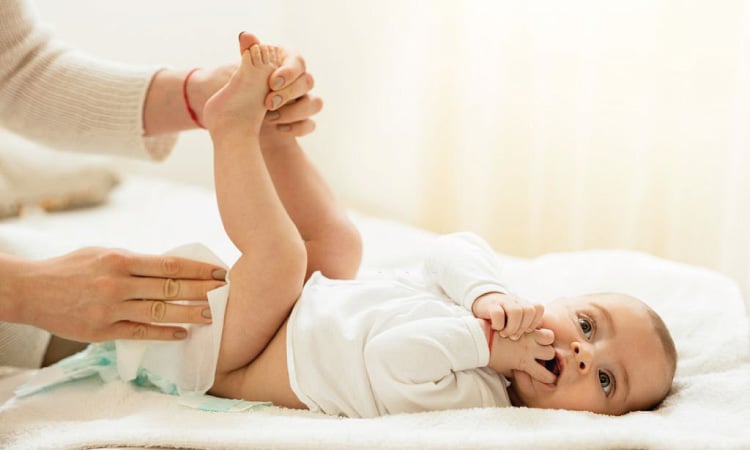Bringing home your new-born was the most momentous and exciting experience you’ve ever had. Even so, it’s perfectly normal to be anxious the first few days after bringing your baby home. New-born care after delivery is not always an easy task for new mothers. It is not uncommon for women to have a lot of questions about new-born baby care after delivery. This article offers some guidance on how to take care of a new-born baby after delivery.
New-Born Care Immediately After Delivery
Care for the new-born begins in the delivery room, where it is administered by medical professionals. To ensure continuity of care, the new-born must be transferred to their parents after educating them and their immediate family members about the do’s and don’ts of new-born care. The instructions should be included in the discharge plan so that there is a guarantee that the new-born will receive adequate care from their family once they are safely at home.
Immediate new-born care after delivery includes:
- The priority care of a new-born immediately after birth involves removing mucus and other materials from the mouth, nose, and throat of the new-born, which is essential for the new-born to breathe
- New-borns’ umbilical cords are fastened with two clamps parallel to one another. The umbilical cord is subsequently severed between the clamps. Before clamping the umbilical cord, the majority of providers wait for at least 30 to 60 seconds for the placental blood to reach the new-born. It is found that delayed cord clamping has many benefits
- The new-born is examined by the physician to determine whether or not, there are any obvious abnormalities or signs of distress
- Using the Apgar score, the new-born’s general health is assessed one and five minutes after birth. A low Apgar score indicates that the infant is experiencing difficulties and may require additional assistance with breathing or blood circulation
- As soon as the new-born is stable, the nurses measure the head circumference, weight, and length
- Warm, sterilized blankets are wrapped around the baby
- A new-born is wet from amniotic fluid and is susceptible to becoming cold. It is crucial to keep the baby warm. When the baby is being born, they are covered in a vernix, which is a white, cheesy, waterproof covering that helps to keep them warm for a while after the birth. To prevent the new-born from losing too much body heat too quickly, the new-born is swaddled as soon as possible in light clothing, and the head is also covered. The baby is also laid carefully on the mother’s body for skin-to-skin contact
- The eyes of the new-born are treated with a few drops of an antibiotic to protect them from infection caused by any potentially dangerous organisms that the new-born may have come into contact with during the delivery process
- If the mother does not develop complications, the new-born will be breastfed within 30 minutes of birth, regardless of the mode of delivery (c-section or normal)
- For a few days after birth, new-borns are incapable of producing vitamin K, which aids in blood clotting. An injection of vitamin K is administered to a new-born. The vitamin K shot will keep your baby from getting the new-born hemorrhagic disease, which is a rare but life-threatening bleeding disorder
- In order to protect your child from the hepatitis B virus (also known as HBV), the hepatitis B vaccine is necessary. Most new-borns receive this shot within the first 24 hours of their lives
Related Reading: 40 Days After Delivery – 8 Precautions And 6 Ways To Spend Them
When Should A New-Born Baby Be Allowed To Come Home?

The length of time a baby spends in the hospital depends on when they are born. Babies who are born healthy and full-term can typically leave the hospital between 24 and 48 hours after giving birth. There is a possibility that some babies born late preterm will be able to return home after a relatively short stay (at least 48 hours). Premature babies with health issues should be kept in the hospital until they need medical attention.
It is possible that women who give birth by c-section will have to stay in the hospital for an extended period of time. Because the mother has undergone surgery, it takes some time for her to recover.
Babies born before 34 weeks of gestation also require more time in the hospital. During this time, the hospital’s medical staff will work closely with the parents to develop a strategy that will help them better understand the specific medical requirements of their baby and give them the confidence to take him/her home safely.
New-Born Care After Delivery At Home- 9 Practical Tips
Routine new-born care after delivery is very important. A new-born infant is extremely fragile and requires a great deal of special attention and care. The neonatal period refers to the first four weeks of a new-born’s life. During this time, the infant undergoes complex physiologic changes and starts responding to stimuli. Continuous and effective care is required during this period. It’s common for a new mother to feel overwhelmed during new-born baby care 1st month. The following tips on new-born care after delivery will help to handle the situation:1
1. Make sure the baby is kept warm
Unlike adults, babies can’t adapt as quickly to changes in temperature. Babies lose heat much more quickly than adults2. As a general rule, a baby ought to put on one or two more layers of clothing than an adult. Put a hat on the baby’s head if it’s cold. The new-born’s head is the primary route through which heat escapes the body. In a hot climate, the baby should never be overdressed. The baby may profusely sweat, feel irritated, and may become cranky. In this situation, choose loose cotton clothing for the baby.
First-time parents should also learn to swaddle their babies in the first few weeks. While permitting some leg movement, proper swaddling keeps a baby’s arms close to its body. Swaddling helps to keep the baby warm. Also, babies who are swaddled appear to be more comfortable and secure than those who aren’t. Besides, the startle reflex, which can awaken a baby, may be reduced with swaddling.
2. Make sure the baby is clean
The truth is that new-borns do not get very dirty. New-borns do not require daily baths. Your baby’s face, hands, feet, neck, armpits, and the backs of their knees are all areas that need to be cleaned more frequently than their arms, legs, and stomach. Skin folds are another area that needs special attention.
However, wash the baby’s face and bottom as needed. You can use gentle baby wipes to clean the baby. Ensure the room is warm before removing the baby’s clothing. While discussing bathing and keeping the baby clean, it is essential to note that soap can often dry out the baby’s skin. We have listed a few important baby hygiene tips, from head to toe.
Some babies are extremely sensitive to chemicals found in even the gentlest cleansers. Gentle, unscented, moisturizing, and free of potentially harmful chemicals are some of the qualities of the best baby soap. Keep the umbilical cord stump clean and dry.
Related Reading: 10 Best Baby Products For Your Baby’s Sensitive Skin
3. Umbilical cord care
By the time your baby is five to fifteen days old, the stump should have dried out and fallen off. Choose sponge baths over tub baths until the stump falls. To keep the umbilical stump clean and free of bacteria, pat it dry after each bath time and apply an antiseptic solution. You can either purchase alcohol from a pharmacy, apply it to a cotton roll, and then dab the affected area, or you can purchase alcohol strips, which are more convenient. However, some physicians advise against applying alcohol to the affected area, believing that stumps should dry naturally. Consult your physician if you are uncertain about this. Also, keep an eye out for the following signs in the belly button area. If you notice any of these, call your pediatrician right away:
- Swelling, tenderness, or redness in the area around the umbilical cord
- The infant cries whenever this area is touched, including by the diaper
- Discharge with or without bad odor
4. Baby holding
The head is the heaviest part of a new-born’s body. Further, new-borns lack neck muscle control to keep their heads up. Therefore, always support your new-born’s head and neck when picking up or holding them. When picking them up, slide one hand under the baby’s head and neck and the other hand under their bottom.
For the first few weeks, the cradle hold is one of the most simple and effective methods of holding a new-born. For safety purposes, hold your infant with both hands as you ascend and descend the stairs. Never shake a new-born. Shaking a new-born increases the risk of a potentially fatal brain hemorrhage.
5. Changing diapers

Typically, a new-born will require eight to twelve diapers per day. Some babies use more diapers, some less. It is a good idea to stock up on diapers before the baby arrives. You may stock cloth diapers, disposable diapers, or both. Know that your baby will quickly outgrow new-born diapers, but still stock a few of them as well. Learn how to change your baby’s diaper beforehand.
It can be difficult to determine how often one should change the diaper of a new-born baby. After the baby has finished each feeding and as soon as they have gone number two, you should generally think about changing their diaper.
Always make sure to give your hands a thorough washing before and after changing a baby’s diaper. Wipe down the baby thoroughly. When cleaning a baby girl, be certain to wipe from front to back.
Use diaper rash powder at each change. It prevents diaper rash by repelling moisture and reducing skin friction. Even if you follow all safe home remedies for the baby diaper rash, you should still be prepared for diaper rash. The moment you notice any redness in the diaper area, use a zinc oxide cream that is both safe and effective.
When putting on the diaper, don’t cover the stump. Alternatively, you can fold the diaper top or cut off the portion that covers the cord.
Related Reading: 10 Best Baby Diaper Brands In India For Your Baby
6. Baby massage
Don’t be afraid to start massaging your new-born soon after birth. There are many scientifically proven benefits of baby massage. It not only strengthens the bond with the baby but also promotes healthy growth.
Research has shown that massages can calm irritable babies, relax them, and improve their sleep patterns. In the initial few weeks, use slow, positive strokes. Avoid spending too much time on a single area.
7. Guidelines for maintaining hygiene
It is crucial to practice good hygiene in the following ways when looking after a new-born at home:
- Wash your hands thoroughly before preparing the baby’s formula, giving the baby a bath, or even dressing or changing the baby
- Diapers for the baby should be kept in a dry location. Mold and fungus will begin to grow on anything that has been sitting still for an extended period of time without being disturbed. These can irritate the skin of your infant. Buy sealable diaper packets and keep naphthalene balls or silica gel packets to absorb moisture
- Additionally, new-born care involves keeping the home immaculately clean. Implement disinfectants on the floor
- Washing baby clothes in the same machine as your other laundry is not recommended. Baby clothing should be washed separately using fabric softener and a mild antibacterial detergent
8. Nursing
Let your baby nurse whenever he wants for the first six weeks. Establishing a feeding schedule too early can affect your milk supply. If you are using the formula to feed your baby, you can easily determine if the baby is getting enough milk. On the other hand, if you are breastfeeding, this may be more difficult to determine. Your baby is probably getting enough milk if he or she appears happy, sleeps soundly, has about six wet diapers and several stools per day, and is consistently gaining weight.
During feeding, babies frequently swallow air, which can make them gassy. Burping after feeding can help prevent this.
9. The best way to put a new-born to sleep
It is normal for new-borns to sleep throughout the day and night. When babies are born, they have no concept of night and day. This is why they are always up and down. Some babies sleep a lot more than others. Because their stomachs are so small, new-borns wake up often to feed.
Here are a few things to take into account when it comes to new-born sleep.
- Make sure that the sleeping surface is flat and firm. For a surface to be firm, it shouldn’t indent when your baby is lying on it
- Put your new-born flat on his back in his crib
- Soft objects and loose bedding should be kept away from your baby’s sleeping area
- The baby’s room should be neither too hot nor too cold. Overheating can make your baby sweaty and increase the risk of SIDS. Similarly, new-borns are susceptible to getting chilled and will likely wake up if they are uncomfortable in a room that is cold
- Dim the lights and create a dark, sleep-inducing environment in the baby’s room
- Under no circumstances should you sleep on the couch with your baby. It is extremely dangerous to try to fall asleep on the couch while holding a baby in your arms because there is a possibility that you will either drop the baby or suffocate it
Related Reading: 18 Baby Proofing Ideas To Ensure There Are No Accidents
Conclusion

Becoming accustomed to looking after a new-born child might take some time. Care for a new-born, which includes everything from carrying, feeding, burping, bathing, massaging, dressing appropriately, and cutting his tiny nails, can be overwhelming at times. With a little bit of practice, you’ll be an expert in no time.
Happy Parenting!

